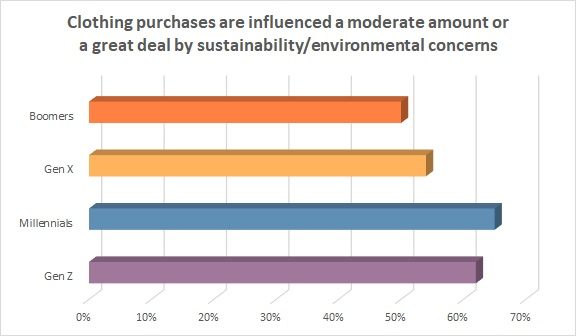CATHERINE SALFINO
As Earth Day approaches this April 22, the fashion industry is once again faced with the part it plays in climate change. But instead of hemming, hawing, and greenwashing its impact, EarthDay.org says it’s time for apparel brands to make measurable change. To prove its seriousness, the agency is calling for federal legislation to be enacted that holds the apparel industry responsible for cutting carbon emissions. It also outlines how brands and retailers can improve, including by changing the fabrics they use away from synthetics.
Any discussion of climate change usually gets around to greenhouse gas (GHG) emissions and how to reduce them. EarthDay.org says the fashion industry alone is responsible for more than 8 percent of GHG emissions.
However, what’s known as “legacy emissions” have been accumulating in the atmosphere for more than 200 years – basically since the industrial revolution began. Experts say simply reducing emissions won’t be enough to prevent further climate change. Instead, they say, climate restoration has to take place. This is where carbon capture comes into force. It’s also where natural fibers like cotton stand to play a helpful part for fashion brands.
See, carbon dioxide (CO2) emissions account for 75 percent of total global emissions, according to the U.S. Environmental Protection Agency (EPA). From 1990 to 2015, CO2 emissions increased 51 percent. The Environmental Defense Fund says one of the best carbon dioxide removal (CDR) methods can be found in trees, since photosynthesis pulls CO2 out of the air and locks it in the trunks, branches, leaves, and roots as the tree grows. But trees aren’t the only natural CDR technique. Cotton has a unique role in the carbon equation, as the cotton plant naturally and efficiently sequester carbon in the soil and in the fiber itself.
“Cotton is made of biogenic carbon or CO2 removed from the atmosphere during the growth of the fiber,” says Cotton Incorporated’s Jesse Daystar, vice president and chief sustainability officer. “The benefit of this capture is not commonly considered in current sustainability tools and data which results in overestimating the global warming impact of cotton clothing.”
Daystar says the cotton plant is very efficient in removing CO2 from the atmosphere and storing it in the soil and cotton fiber.
“So, when you have a closet full of cotton products, because cotton plants have captured and stored carbon, it’s similar to the way trees and plants maintain carbon in a forest,” Daystar says. “As the world’s population grows, there will only continue to be more cotton in our closets, which will continue to hold CO2 in our closets that would otherwise be in the atmosphere.”
This win for apparel is also a win for the planet. And it couldn’t come too soon, as far as consumers are concerned. The majority of shoppers (75 percent) says concern about the environment is real and requires change, according to the Cotton Council International (CCI) and Cotton Incorporated’s 2021 Global Sustainability Survey.
The change sought by EarthDay.org includes calling on the Biden Administration to enact legislation that not only holds the fashion industry responsible for cutting carbon emissions, but requires the industry to be responsible for sustainably disposing of its waste materials and used clothing, halts the use of any and all virgin synthetic materials, and imposes a carbon tax on all apparel made from virgin synthetic materials, among other points.
Consumers would likely welcome such industry changes, as nearly 6 in 10 (58 percent) say sustainability/environmental concerns influence their clothing purchases, according to the 2021 Global Sustainability Survey. That figure jumps to 65 percent among Millennials and 62 percent among Gen Z.

When asked why sustainability influences their apparel purchases, 64 percent of consumers say, “It is important to me to do whatever I can to improve the environment,” according to the 2021 Global Sustainability Survey. Another 63 percent say, “It is important to me that these products can return to the earth by being biodegradable/compostable.” That number increases significantly to 74 percent among Gen Z shoppers.
According to the World Economic Forum, clothing production has roughly doubled since 2000. Consumers bought 60 percent more garments in 2014 than they did in 2000, yet they kept the clothes for just half as long. This is taking toll on the earth’s landfills, as 85 percent of all textiles wind up in the dump each year.
Now, consider that more than two-thirds of all apparel (69 percent) is made of synthetic or manmade fibers. Further, less than 1 percent of apparel is actually recycled into new clothing, according to the Ellen MacArthur Foundation. So, all those clothes that end up in the dump? They’re mostly made of synthetics. And the World Economic Forum says the equivalent of one garbage truck full is dumped or burned in a landfill every second. The EPA says half the gas coming from landfills is carbon dioxide. Add to this the fact that synthetic fabrics can take decades if not hundreds of years to biodegrade, according to Common Objective, a tech solution for sustainable fashion business.
Alternately, cotton biodegrades relatively quickly in both water and soil because it is made of cellulose, an organic compound that is the basis of plant cell walls and vegetable fibers. Research has shown cotton’s biodegradability is 99 percent greater than synthetics in a compost environment, decomposing 89 percent in 12 weeks versus 0.8 percent for synthetics.
Daystar says that by 2025, cotton producers and industry organizations are working to increase soil carbon by 30 percent and decrease greenhouse gas emissions by 39 percent. He adds that people talk about net zero emissions as the “ultimate” goal and believes the cotton industry can play an important role in getting there.
“Yes, it’s an important goal—but, ultimately, I would love cotton to be net negative,” Daystar states. “Within the textile/apparel space, cotton has a unique opportunity not only to reduce climate change impacts but perhaps to capture more carbon than it releases. Cotton currently does that on a cradle-to-gate basis, meaning that, from seed to bale of cotton, it has captured more CO2 emissions than it has released. As we continue to improve our practices and processes throughout cotton’s life cycle, especially during manufacturing/finishing and through recycling/composting, we hope to reach a net negative for carbon’s entire life cycle.”
To learn more about cotton sustainability, please visit CottonToday.


